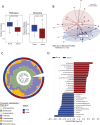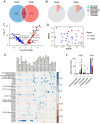Diet changes due to urbanization in South Africa are linked to microbiome and metabolome signatures of Westernization and colorectal cancer
- PMID: 38643180
- PMCID: PMC11032404
- DOI: 10.1038/s41467-024-46265-0
Diet changes due to urbanization in South Africa are linked to microbiome and metabolome signatures of Westernization and colorectal cancer
Abstract
Transition from traditional high-fiber to Western diets in urbanizing communities of Sub-Saharan Africa is associated with increased risk of non-communicable diseases (NCD), exemplified by colorectal cancer (CRC) risk. To investigate how urbanization gives rise to microbial patterns that may be amenable by dietary intervention, we analyzed diet intake, fecal 16 S bacteriome, virome, and metabolome in a cross-sectional study in healthy rural and urban Xhosa people (South Africa). Urban Xhosa individuals had higher intakes of energy (urban: 3,578 ± 455; rural: 2,185 ± 179 kcal/d), fat and animal protein. This was associated with lower fecal bacteriome diversity and a shift from genera favoring degradation of complex carbohydrates (e.g., Prevotella) to taxa previously shown to be associated with bile acid metabolism and CRC. Urban Xhosa individuals had higher fecal levels of deoxycholic acid, shown to be associated with higher CRC risk, but similar short-chain fatty acid concentrations compared with rural individuals. Fecal virome composition was associated with distinct gut bacterial communities across urbanization, characterized by different dominant host bacteria (urban: Bacteriodota; rural: unassigned taxa) and variable correlation with fecal metabolites and dietary nutrients. Food and skin microbiota samples showed compositional differences along the urbanization gradient. Rural-urban dietary transition in South Africa is linked to major changes in the gut microbiome and metabolome. Further studies are needed to prove cause and identify whether restoration of specific components of the traditional diet will arrest the accelerating rise in NCDs in Sub-Saharan Africa.
© 2024. The Author(s).
Conflict of interest statement
The authors declare no competing interests.
Figures





References
-
- Sung H, et al. Global Cancer Statistics 2020: GLOBOCAN estimates of incidence and mortality worldwide for 36 cancers in 185 countries. CA Cancer J. Clin. 2021;71:209–249. - PubMed
-
- Reynolds A, et al. Carbohydrate quality and human health: a series of systematic reviews and meta-analyses. Lancet. 2019;393:434–445. - PubMed
MeSH terms
Supplementary concepts
Grants and funding
LinkOut - more resources
Full Text Sources
Medical

